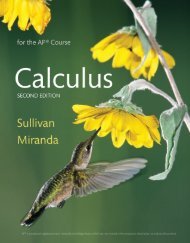Sullivan Microsite TE SAMPLE
Create successful ePaper yourself
Turn your PDF publications into a flip-book with our unique Google optimized e-Paper software.
<strong>Sullivan</strong> AP˙<strong>Sullivan</strong>˙Chapter01 October 8, 2016 17:4<br />
Section 1.5 • Infinite Limits; Limits at Infinity; Asymptotes 129<br />
y<br />
2<br />
2<br />
4<br />
Figure 51 f (x) = ln x<br />
y f (x)<br />
lim<br />
x→c<br />
c x<br />
c x<br />
x→c x→c <br />
(a) lim f (x) ∞ (b) lim f(x) ∞<br />
Figure 50<br />
2 4<br />
x<br />
So, there are four possible one-sided infinite limits of a function f at c:<br />
x→c<br />
x→c<br />
x→c +<br />
f (x) =∞, lim f (x) = −∞, lim f (x) =∞, lim<br />
− − +<br />
See Figure 50 for illustrations of these possibilities.<br />
y f (x)<br />
c<br />
y f (x)<br />
(c) lim f (x) ∞<br />
x→c <br />
x<br />
c<br />
f (x) = −∞<br />
(d) lim f (x) ∞<br />
x→c <br />
y f (x)<br />
When we know the graph of a function, we can use it to investigate infinite limits.<br />
EXAMPLE 2<br />
Investigate lim ln x.<br />
x→0 +<br />
Investigating an Infinite Limit<br />
Solution The domain of f (x) = ln x is {x|x > 0}. Notice that the graph of f (x) = ln x<br />
in Figure 51 decreases without bound as x approaches 0 from the right. The graph<br />
suggests that<br />
lim ln x = −∞<br />
x→0 +<br />
■<br />
x<br />
NOW WORK Problem 11.<br />
Based on the graphs of the trigonometric functions in Figure 52, we have the<br />
following infinite limits:<br />
lim tan x =∞ lim<br />
x→π/2− lim csc x = −∞ lim<br />
x→0− tan x = −∞ lim<br />
x→π/2 +<br />
csc x =∞ lim<br />
x→0 +<br />
sec x =∞ lim<br />
x→π/2− cot x = −∞ lim<br />
x→0− sec x = −∞<br />
x→π/2 +<br />
cot x =∞<br />
x→0 +<br />
Teaching Tip<br />
Students should have sound knowledge<br />
of the graphical representations of the<br />
basic functions. In particular, they should<br />
be able to quickly sketch and identify the<br />
asymptotes of the following functions:<br />
y = tanx<br />
y = csc x<br />
y = sec x<br />
y = cot x<br />
y =<br />
y<br />
e x<br />
= e −x<br />
y = lnx<br />
1<br />
y =<br />
x<br />
Teaching Tip<br />
Consider presenting the students with the<br />
following graph:<br />
y<br />
y<br />
5<br />
5<br />
π<br />
x 2<br />
Figure 52<br />
y<br />
y<br />
y<br />
y tan x y sec x<br />
y csc x y cot x<br />
π<br />
x<br />
5<br />
5<br />
π<br />
x<br />
π<br />
<br />
2<br />
5<br />
5<br />
π<br />
x x 0<br />
x 0<br />
2<br />
π<br />
2<br />
Limits of quotients, in which the limit of the numerator is a nonzero number and<br />
the limit of the denominator is 0, often result in infinite limits. (If the limits of both<br />
the numerator and the denominator are 0, the quotient is called an indeterminate form.<br />
Limits of indeterminate forms are discussed in Section 4.5.)<br />
x<br />
π<br />
<br />
2<br />
5<br />
5<br />
π<br />
2<br />
x<br />
Ask them to draw a function such that<br />
1. lim fx ( ) =∞<br />
x→c<br />
−<br />
2. lim fx ( ) =∞<br />
x→ c<br />
+<br />
3. lim fx ( ) =−∞<br />
x→c<br />
−<br />
4. lim fx ( ) =−∞<br />
x→ c<br />
+<br />
A few possible answers are at the top of<br />
page 129 of the student edition. Students<br />
can show their graphs to students around<br />
them and troubleshoot misconceptions.<br />
c<br />
x<br />
Section 1.5 • Infinite Limits; Limits at Infinity; Asymptotes<br />
129<br />
<strong>TE</strong>_<strong>Sullivan</strong>_Chapter01_PART II.indd 12<br />
11/01/17 9:55 am




